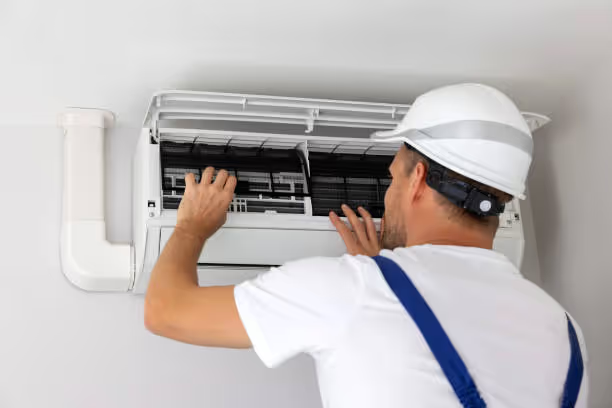HVAC Installation in Tampa, FL

Expert HVAC installation in Tampa, FL, is crucial for your home's long-term comfort and efficiency. This page details when to consider a new AC system, highlighting indicators like age, rising energy bills, and frequent repairs, and offers guidance on repairing versus replacing. Our comprehensive installation process involves an in-depth home assessment, tailored system recommendations, meticulous setup by certified technicians, thorough ductwork inspection, rigorous testing, and a final educational walkthrough. We ensure your new system provides optimal performance and reliable comfort.

Expert HVAC Installation in Tampa, FL
Investing in a new HVAC system is one of the most significant decisions a homeowner can make, especially in a climate like Tampa’s where reliable cooling and heating are essential for daily comfort. A proper installation is not just about placing a new unit; it's a comprehensive process that determines your system's efficiency, longevity, and performance for years to come. At Sunstate Mechanical Contractors, Inc., we provide meticulous, professional HVAC installation services, ensuring your home receives the precise comfort control it deserves. Our approach combines decades of local expertise with a commitment to technical excellence, giving you lasting peace of mind.
When to Consider a New HVAC System
Deciding to replace your HVAC unit can feel daunting, but your current system often provides clear signals that its service life is ending. Proactively planning for a replacement allows you to avoid the stress and expense of an emergency breakdown during a Tampa heatwave. Key indicators that it may be time for a new installation include:
- System Age: Most air conditioners in Florida last 10-15 years, while furnaces can last 15-20 years. If your system is approaching or has surpassed this range, its efficiency is likely declining significantly.
- Rising Energy Bills: A sudden or steady increase in your utility costs without a change in usage habits often points to an aging, inefficient HVAC system working harder to maintain the set temperature.
- Frequent and Costly Repairs: If you find yourself scheduling repairs multiple times a year, the cumulative cost can quickly approach the price of a new, reliable unit. A single major component failure, such as a compressor or heat exchanger, can also make replacement the more financially sound option.
- Uneven Temperatures: Rooms that are consistently too hot or too cold, despite a functioning thermostat, can indicate an improperly sized system or failing components that can no longer distribute air effectively.
- Excessive Noise or Dust: Loud grinding, rattling, or squealing noises are signs of serious mechanical issues. An increase in dust and poor indoor air quality can also suggest your system is failing to filter air properly.
Making the Right Choice: Repair vs. Replace
The decision to repair or replace your HVAC system involves balancing short-term costs against long-term value. A helpful guideline is to consider the age of your unit and the cost of the repair. If the repair cost multiplied by the age of the system (in years) exceeds the cost of a new installation, replacement is often the smarter investment.
Beyond this simple rule, consider the benefits of modern technology. New systems feature significantly higher SEER2 (Seasonal Energy Efficiency Ratio 2) ratings, meaning they use far less energy to cool your home, leading to substantial savings on your monthly bills. Upgrading also provides an opportunity to choose a system correctly sized for your home, improving comfort and air quality while operating with quieter, more reliable technology. Our technicians can provide a thorough assessment of your current system, offering transparent advice to help you make an informed decision that aligns with your budget and long-term comfort goals.
Our Comprehensive HVAC Installation Process
A flawless installation is the foundation of an effective and durable HVAC system. We have refined our process to ensure every detail is handled with precision, transparency, and respect for your home.
- In-Depth Home Assessment: Our process begins with a thorough evaluation of your home. We don't just look at your old unit; we analyze your home's square footage, layout, insulation quality, window types, and existing ductwork. This allows us to perform an accurate load calculation to determine the exact size and capacity of the system your home requires.
- Customized System Recommendation: Based on our assessment, we present you with tailored options from leading brands like Trane, American Standard, and Carrier. We explain the benefits of different system types—from high-efficiency central air conditioners to versatile heat pumps—and discuss SEER2 ratings and features, empowering you to select the perfect fit for your comfort needs and budget.
- Meticulous and Professional Installation: Our licensed and certified technicians carry out the installation according to manufacturer specifications and local building codes. We handle the safe removal and disposal of your old equipment, expertly install the new indoor and outdoor units, and ensure all electrical and refrigerant line connections are secure and correct.
- Ductwork Inspection and Sealing: The efficiency of your new system is heavily dependent on your ductwork. We inspect your ducts for leaks, damage, or improper sizing, making recommendations for sealing or repairs to ensure conditioned air reaches every room without loss.
- Rigorous System Testing and Commissioning: Once installed, we don't just turn the system on. We perform a series of tests to verify correct refrigerant levels, check airflow, calibrate the thermostat, and ensure all safety controls are functioning perfectly. This commissioning process guarantees your system operates at peak performance from day one.
- Final Walkthrough and Education: Your comfort and confidence are our priorities. We conduct a final walkthrough with you, demonstrating how to operate your new system and thermostat, explaining maintenance requirements, and answering any questions you may have.
Factors That Influence Your HVAC Installation
Understanding the components of an HVAC installation helps clarify the investment. Several key factors determine the final scope of the project:
- System Type and Size: The choice between a central AC, heat pump, or furnace, along with its capacity (measured in tonnage), is the primary cost factor.
- Energy Efficiency (SEER2): Systems with higher SEER2 ratings have a higher upfront cost but deliver greater long-term energy savings.
- Brand and Model: Different manufacturers offer a range of models with varying features, technologies, and warranty coverages.
- Ductwork: The condition of your existing ductwork is crucial. If it requires significant repairs, sealing, or a complete replacement, this will impact the overall project.
- Installation Complexity: Factors such as the accessibility of the installation area, necessary electrical upgrades, or modifications to accommodate the new unit can influence labor requirements.










